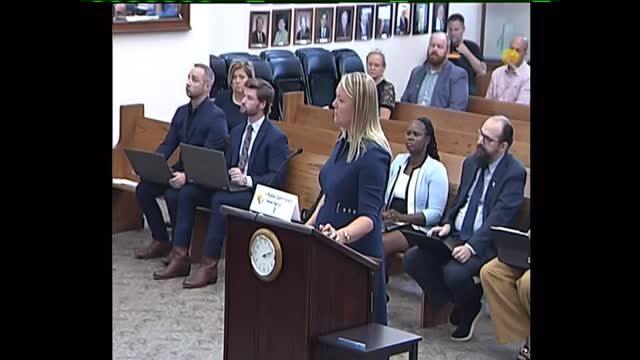Townhome development sparks heated debate over density and design
September 04, 2024 | Pasco County, Florida
This article was created by AI summarizing key points discussed. AI makes mistakes, so for full details and context, please refer to the video of the full meeting. Please report any errors so we can fix them. Report an error »

In a recent government meeting, discussions centered around a proposed development plan for townhomes and multifamily units, highlighting concerns over density and design requirements. Commissioner Starkey initiated the conversation by referencing a map that indicated 82 rear-loaded townhomes, as outlined in the project’s legend. However, questions arose regarding the actual requirements, which stipulate that only 20% of the total townhomes need to be rear-loaded. This could potentially reduce the number of rear-loaded units to as few as 32 if the total count remains at 160 townhomes.
The dialogue revealed significant apprehension among board members about the implications of such a reduction. One member expressed concern that the proposed plan might lead to a drastic decrease in the number of rear-loaded townhomes, which are seen as essential for maintaining the aesthetic and functional integrity of the community. The importance of linear parks and pedestrian connectivity was also emphasized, with the townhomes strategically placed to enhance these features.
Further complicating the discussion was the proposal for multifamily units, which initially included 288 units but allowed for flexibility up to 350. This raised eyebrows among board members, who questioned the rationale behind such a high cap. The developer clarified that the multifamily designation encompasses both apartments and carriage homes, with the latter being a two-story structure featuring a garage and an apartment above.
As the meeting progressed, members expressed a desire for a more balanced approach to density, suggesting that a lower number of multifamily units might be more acceptable. One commissioner urged the team to adhere to the numbers presented in the legend, advocating for no less than the proposed 82 rear-loaded townhomes and 52 carriage homes, reflecting a commitment to quality development that aligns with community standards.
The meeting underscored the ongoing tension between development flexibility and community expectations, as officials seek to navigate the complexities of urban planning while addressing the needs and concerns of local residents.
The dialogue revealed significant apprehension among board members about the implications of such a reduction. One member expressed concern that the proposed plan might lead to a drastic decrease in the number of rear-loaded townhomes, which are seen as essential for maintaining the aesthetic and functional integrity of the community. The importance of linear parks and pedestrian connectivity was also emphasized, with the townhomes strategically placed to enhance these features.
Further complicating the discussion was the proposal for multifamily units, which initially included 288 units but allowed for flexibility up to 350. This raised eyebrows among board members, who questioned the rationale behind such a high cap. The developer clarified that the multifamily designation encompasses both apartments and carriage homes, with the latter being a two-story structure featuring a garage and an apartment above.
As the meeting progressed, members expressed a desire for a more balanced approach to density, suggesting that a lower number of multifamily units might be more acceptable. One commissioner urged the team to adhere to the numbers presented in the legend, advocating for no less than the proposed 82 rear-loaded townhomes and 52 carriage homes, reflecting a commitment to quality development that aligns with community standards.
The meeting underscored the ongoing tension between development flexibility and community expectations, as officials seek to navigate the complexities of urban planning while addressing the needs and concerns of local residents.
View full meeting
This article is based on a recent meeting—watch the full video and explore the complete transcript for deeper insights into the discussion.
View full meeting